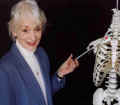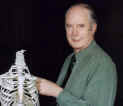 |
 |
 |
Helping You To Achieve ©™

![]()
Helping You To Achieve ©™
|
|
Draw with a skin marking pencil the projected outline of the Sacrum on a model in the Anatomical Position with side lighting and a time limit of two minutes.
Objective No 89 - Criteria to be demonstrated. 1. Identify and surface mark the Posterior Superior Iliac Spines. (Objective No 86) 2. Observe that the Posterior Superior Iliac Spines lie 5cm from the Median plane. 3. Draw a line between the two Posterior Superior Iliac Spines. 4. Note that the line cuts through the body of the Second Sacral Spinous process. 5. Observe the Natal Cleft and the inverted triangle formed between the two dimples overlying the Posterior Superior Iliac Spines and the Natal Cleft. 6. The tip of the Apex of the Natal Cleft lies on a level with the Third Sacral Spine. 7. Join the Points marking the dimples to form the base of a triangle and the tip of the Natal Cleft to form the Apex. 8. Inferior to the Triangle apex the Sacral Hiatus can be located. 9. Superior to the horizontal line joining the dimples overlying the Posterior Superior Iliac Spines is located the First Sacral Vertebra. 10. Note that the Posterior Superior Iliac Spine lies over the mid point of a line indicating the surface marking of the Sacro-iliac Joint.
|
Service ProvisionBronze. Students may take up a ,'Free start up ' package consisting of 100 of the behavioural objectives and criteria based on common questions asked in Living Anatomy. These are available free of charge on this Website. Silver. Students may buy a copy of the book "Surface and Living Anatomy" (ISBN: 0 7234 3261 9) which comes with a CD Rom (Windows PC format) containing 230 objectives which includes the 100 behavioural objectives contained in the Bronze Service. Gold "Helping you to Achieve" Contact Information
|